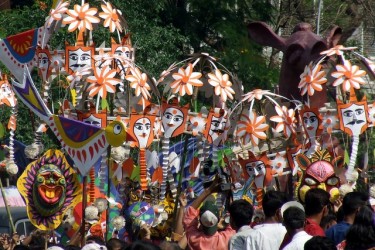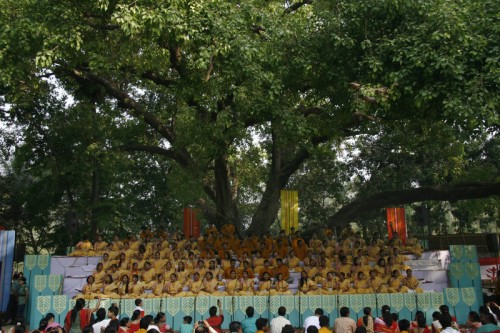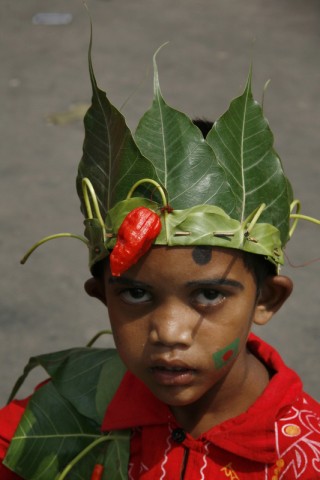This post was written in Bangla by Pantha Rahman Reza and was translated by Rezwan for Global Voices Online.
Tomorrow is Pahela Baisakh
(first day of summer, Bengali news year), the favorite festival of the
Bengalis. Every year Bengalis celebrate their new year with galore. The
first day of the new year is filled with festivities. Wherever there are
Bengalis in the world, they celebrate this day with different events.
On this day everybody wears traditional clothes. The girls are draped in Saris and the boys wear Panjabi/Fatua (longer or shorter version of Kurtas). The shopping malls are engaged in brisk business. Especially worth mentioning are the summer collections by fashion houses targeting this day.
AlAmin90 shares what he presented his loved one:
One of the main attractions of Pahela Baisakh celebrations is the
Panta-Ilish meal. Many houses prepare special cuisine including Panta Bhat (lightly fermented rice) and Ilish (Hilsha) fish cooked with mustard and green chili. As the demand of Ilish fish soars during Pahela Baisakh the price goes up steeply [bn].
Every year after the sunrise a colorful rally called Mangal Shovajatra
[bn] starts in front of the graphics arts institute of Dhaka
University. This rally rolls across many streets of the city and comes
back to the institute. The masks and placards of the rally portraits the
rural life and the daily affairs of Bengal. Blogger Tung Tang was in one such rally [bn] and tells about it:
In Bangladesh, the main celebrations of Pahela Baisakh take place in Dhaka, the capital. Cultural organization Chayanat
[bn] arranges new year's concert at the Batamul of Ramna and one of the
main feature is the rally of the graphics arts institute. Many people
come to this area to celebrate.
Every Bengali has something to share about this day, especially the childhood memories of joining the festivities of Pahela Baisakh. Sheikh Jalil at Sachalayatan reminisces about his childhood memroies of this day:
Pahela Baisakh is now celebrated across the classes, although it was only a funfair of the middle income Bengalis. Blogger Ektutells [bn] more about that:
Bangladesh is a developing country. Its per capita income is 828 USD [bn]. There are many problems in the country like political disturbances and unemployment. But during Pahela Baisakh everybody forgets that and joins in funfair. Everybody shares the enjoyment and celebrations. S. M. Rahat Khan shares (with picture) the same [bn] at Somewhereinblog.
On this day everybody wears traditional clothes. The girls are draped in Saris and the boys wear Panjabi/Fatua (longer or shorter version of Kurtas). The shopping malls are engaged in brisk business. Especially worth mentioning are the summer collections by fashion houses targeting this day.
AlAmin90 shares what he presented his loved one:
পহেলা বৈশাখের জন্য দিনাকে আমি সাদা-লাল রংয়ের জামদানি কাপড় গিফট করলাম। আর হাতের লাল চুড়ি, মাটির গহনা আর লাল টিপ।
For Pahele Baisakh I gifted Dina a red-white Jamdani Sari. Along with that red churis (glass bangles), ornaments made of clay and red teep (Bindi).
 |
| The colorful rally organized by the graphic arts institute. Image courtesy Wikipedia |
চারুকলার ঢুকে প্রথমে চোখে পরবে মাটির সরা তারপর এ আছে মুখোশ বানানোর কাজ। মাটির সরায় কাজ করছে চারুকলার শিক্ষার্থীরা বিভিন্ন রং বিভিন্ন থিম এর। নির্দ্দিষ্ট কোন থিম নেই, তবে বেশির ভাগ সরার ডিজাইন লোকজ সংস্কৃতির গ্রামীণ জীবন এবং আবহমান বাংলা ঐতিহ্যর উপরে। পহেলা বৈশাখের মঙ্গল শোভাযাত্রা যে কয়টি প্রচলিত আইটেম এর মধ্য রয়েছে মুখোশ, সরা আর কিছু প্রাণীর প্রতিলিপি ।
The Bengali new year celebrations started during the Mughal era (15th century). In those days the region had Zamindar system. The peasants used to pay tax to the Zamindars till the last day of spring. On the first day of summer (Pahela Baisakh) the Zamindars used to distribute sweets to the farmers. To celebrate this many festivities used to be arranged, fairs took place. Pahela Baisakh become a part of peoples' lives ever since. Gradually it became more festive and full of enjoyment.If you go to the graphics arts institute, the first thing you will notice are the clay pots and then you will see people crafting and painting masks. The students of graphics arts institute are painting the clay pots in different themes of colors. There is no fixed theme, but many pots are painted with the rural life and the daily affairs of Bengal. The typical items of the Pahela Baisakh rally are Masks, clay pots and modelling of some animals.
 |
| Chayanat's concert at the Ramna Batamul. They are welcoming the new year with songs. Image by Abu Ala. Copyright Demotix. |
Every Bengali has something to share about this day, especially the childhood memories of joining the festivities of Pahela Baisakh. Sheikh Jalil at Sachalayatan reminisces about his childhood memroies of this day:
বৈশাখ এলেই মনে পড়ে বৈশাখী মেলার কথা। গ্রামের হাট-বাজারে বসতো এ মেলা। নাগরদোলায় চলা, লাঠিখেলা দেখা, বায়স্কোপ দেখা, মেলা থেকে মুড়ি-মুড়কি-বাতাসা-সন্দেশ-মিষ্টি কিনে খাওয়া আমার শৈশব বেলার স্মৃতি। বাবা-মা, বড় ভাই-বোনের হাত ধরে মেলায় যেতাম। তারা কিনে দিতেন বাঁশি চরকী, বেলুনসহ আরো কত কী? সাপুড়েদের সাপ খেলা, বানরের খেলা আর ষাঁড়ের লড়াই দেখতাম এ সময়। সত্যিকারে আশেপাশের কয়েকটি গ্রামের মিলনকেন্দ্র ছিল আমাদের বৈশাখী মেলা। হিন্দু-মুসলমান সবাই মিলে আনন্দ-উল্লাস করে বৈশাখের প্রথম কয়েকটা দিন কেটে যেত।
Those who are abroad and cannot join the Bengali new year festivities regret that. A diaspora blogger writes [bn]:I remember about the Baisakhi fair every summer. It usually took place in the rural bazaars. The Nagordola (ferris wheel), Lathikhela (play with sticks), Bioscope shows, and going home with sweet treats like Muri-Murki-batasha-Sandesh-Sweets are parts of my childhood memories. I used to go to the fairs with my parents and siblings. They used to buy me flutes, Chorki, balloons and what not. The other attractions were snake charming plays, monkey games and bull fights. Our Baisakhi fair was a huge funfair of several villages. Hindu-Muslim alike spent the first days of the summer with merriment.
বৈশাখ মানেই গ্রামহারা শহরহারা দেশ ছাড়া হয়ে বিশ্বের কোন এক ব্যাস্ত নগরীতে বসে শুধুই স্মৃতির জাবর কাটা, টেলিভিশনের পর্দায় রমনার বটমূল আর তরুন তরুনীদের গালে রঙের ছটা দেখা। হায়রে বৈশাখ তুই কি কখনোই শহরে আসবিনা? শহরের সাথে কি তোর চিরকালই আড়ি?
Baisakh means far from the villages, reminiscing in a busy city somewhere in the world, watching ramna Batamul and the paintings on the cheeks of boys and girls on the television screen. Oh Baisakh, won't you ever come to the city?
 |
| New years decoration - a little boy with a crown of leaves. Image by Abu Ala. Copyright Demotix |
বৈশাখের এ উত্সব, মানুষের সর্বজনীন এ অংশগ্রহণ দুই দশক আগেও এরকম ছিল না। বৈশাখের উৎসব আমেজ, ভালো রান্না আর অনুষ্ঠানমালা সীমাবদ্ধ ছিল মধ্যবিত্ত সংস্কৃতিমনা কিছু মানুষের মধ্যে। ছায়ানটের অনুষ্ঠান হতো বটতলায়। সেখানেও অংশগ্রহণ ছিল সংস্কৃতিকর্মী ও মধ্যবিত্ত একটি শ্রেণীর। গত দুই দশক ধরে বৈশাখ বরণে ব্যাপক পরিবর্তন এসেছে। বৈশাখ বরণের রং মধ্যবিত্তের গণ্ডি পেরিয়ে উচ্চবিত্ত ও নিম্নবিত্তের মানুষের মধ্যেও ছড়িয়ে পড়েছে। বৈশাখের অনুষ্ঠানে বেড়ে চলেছে সর্বশ্রেণীর মানুষের অংশগ্রহণ। […] নিম্নবিত্ত সাধারণ শ্রমজীবী মানুষও বৈশাখের জন্য আলাদা করে রাখছে তার ঘামে উপার্জিত অর্থের একটি অংশ। সাধ্যমত গায়ে তুলছে বৈশাখের পোশাক। ঘুরতে বের হচ্ছে প্রিয়জনের সঙ্গে। মেলা থেকে কিনে আনছে শৌখিন কিছু।
There are many programs arranged by different socio-cultural organizations during the whole day. On this day Bangladesh Open Source Network (BDOSN) is campaigning [bn] to portray the culture and tradition of the country in Wikipedia.Only two decades ago the Baisakh festivities and the universal celebration were not like this. The programs, festivities and the food culture were confined within some middle class cultural minded people. Chayanat used to arrange their program at Batamul on this day. Only cultural activists and people of middle class were seen there. But a lot has changed in the past two decades. The colors of welcoming summer has spread to the higher and lowers classes of people. Now it has truly become a festival for masses. [..] Even the working class people are saving a budget from their meager income for the Pahela Baisakh festivities. They are buying special clothes for this day, going out with loved ones. They are buying something from the fairs.
Bangladesh is a developing country. Its per capita income is 828 USD [bn]. There are many problems in the country like political disturbances and unemployment. But during Pahela Baisakh everybody forgets that and joins in funfair. Everybody shares the enjoyment and celebrations. S. M. Rahat Khan shares (with picture) the same [bn] at Somewhereinblog.
লাল-সাদা শাড়িতে……পাঞ্জাবিতে…চারদিক এত বর্ণিল…কে বলবে পৃথিবীর একটি গরিব দেশ বাংলাদেশ? কে বলবে নানা কষ্ট আর না পাওয়ার দেশ বাংলাদেশ? সবাই যেন সব ভুলে একটি দিনের জন্য হলেও সুখের স্বর্গে পরিণত করে বাংলাকে…
In red-white Saris.. Panjabis… every place is
so colorful.. who will say that Bangladesh is a poor country in the
world. Who will say that Bangladesh is a country full of deprivation and
pain. Everybody forgets those to make this day a heaven of happiness…
























0 comments:
Post a Comment